
The happy childlike paintings of Canadian folk artist Maud Lewis belie the many adversities and challenges she faced throughout her life.

Looking at her peaceful scenes of winding country lanes, sleepy boat harbors, and charming cats amongst tulips and blossom-laden branches, it’s hard to imagine she lived most of her life in a cramped one-room house with no running water or electricity, barely able to hold a paint brush with her gnarly, arthritic hands.



Born in Yarmouth, Nova Scotia in 1901, Maud Dowley was a solitary child, uncomfortable around others because of her differences. She was smaller than most, and because of birth defects, had hunched shoulders, almost no chin, and painfully deformed hands. Juvenile rheumatoid arthritis further reduced her mobility. Teased mercilessly by the other kids, she dropped out of school at age 14.
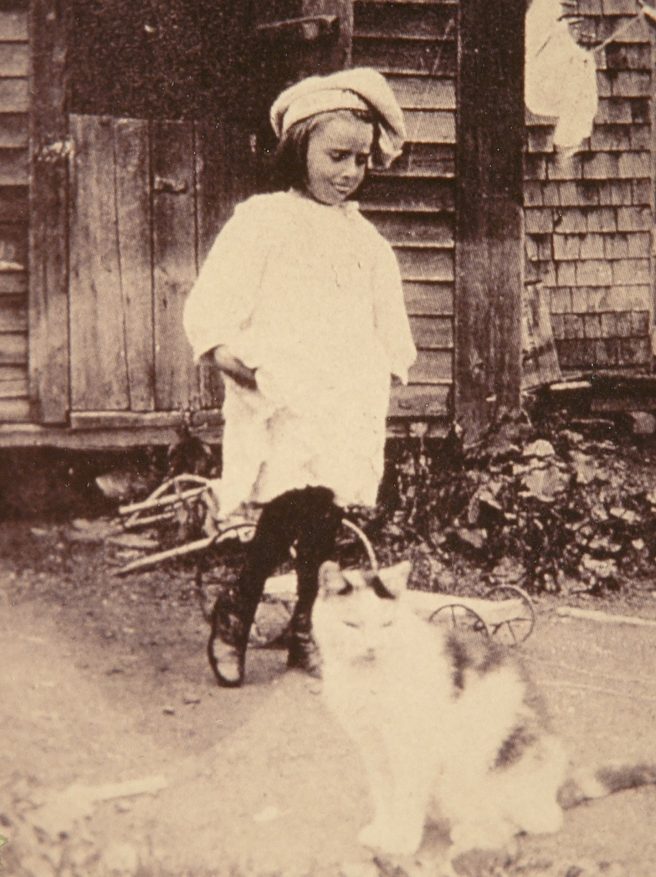
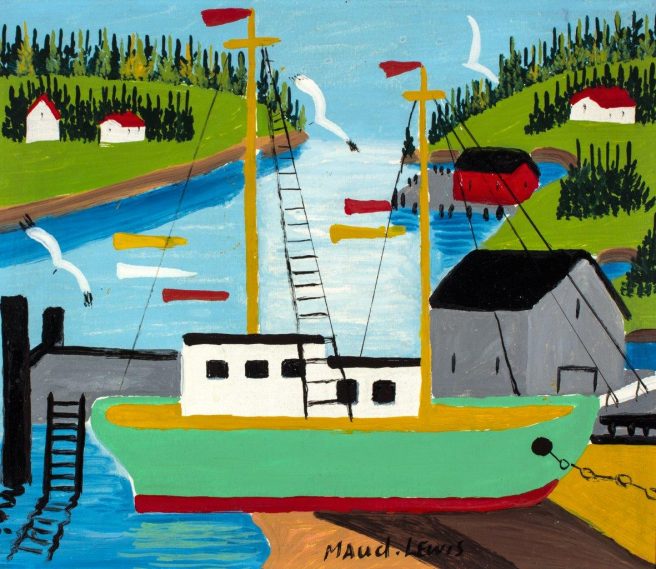

Though she was painfully shy, she had a sweet disposition and was basically happy spending time with her parents and older brother. After her mother introduced her to watercolors, Maud painted Christmas cards to sell to their neighbors, thus officially beginning her artistic career.
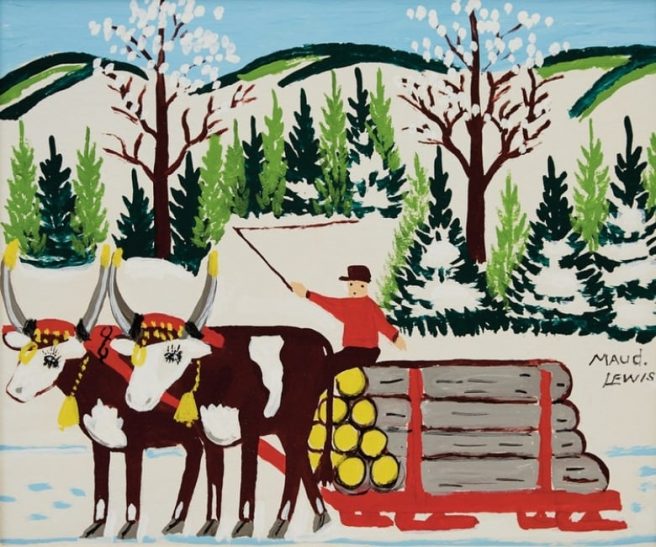
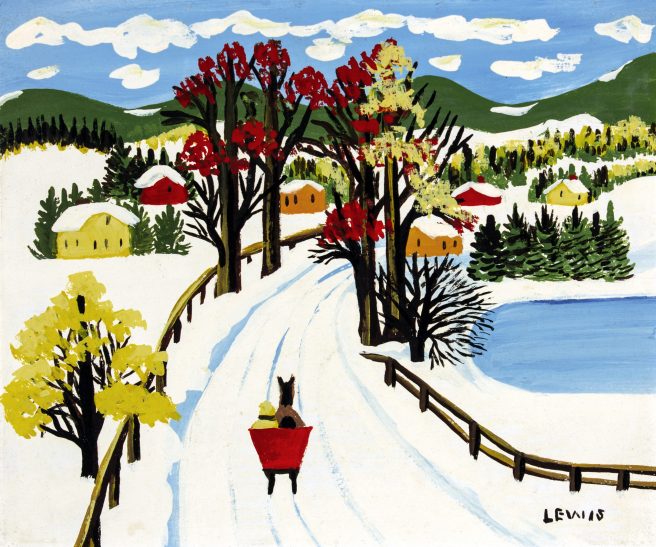

After her parents died, her brother inherited the family home, but selfishly made no provisions for Maud, who had had a child out of wedlock. The love of Maud’s life apparently abandoned her because of this scandal, and Maud’s baby daughter, given up for adoption, never saw her birth mother again.
Maud then moved to Digby (about 65 miles away) to live with her aunt. There, she met fish peddler Everett Lewis after answering his ad for a live-in housekeeper. She married him at age 34 a short while later.
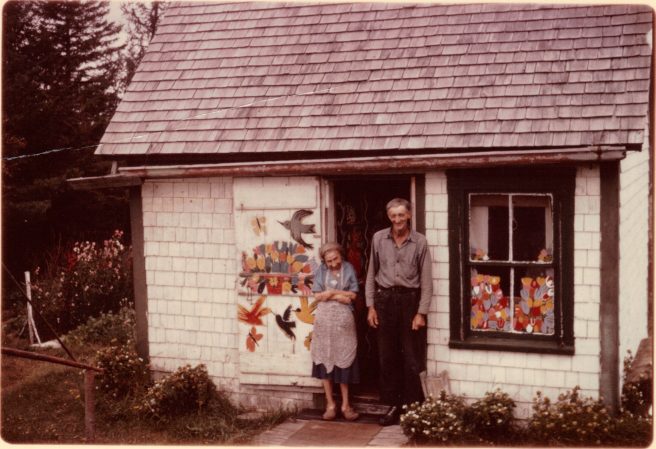
She would spend the rest of her life — three decades — living with Everett in his tiny cottage in Marshalltown that also served as her studio.
Although Everett was an irascible character, he encouraged Maud to paint and scrounged for supplies (including leftover house and boat paint). When Maud’s worsening arthritis made it difficult to do physical work, Everett took over housekeeping chores while Maud covered almost every available surface with flowers, birds, butterflies, and animals.



Soon Maud’s efforts brought in a little money; she would accompany Everett on his daily rounds and sell handpainted Christmas cards to his customers for five cents each. Their popularity encouraged Maud to paint larger pieces, using as canvas whatever was available (beaverboard, Masonite, cardboard, cookie sheets, wallpaper). Everett bought her first set of oil paints.


She placed a “Paintings for Sale” sign in front of their house to attract customers driving by. Everett was usually the one to negotiate prices as Maud hesitated to charge more than a few dollars. He also squirreled away her modest profits, hiding money in an attic lockbox and in jars buried in the garden.

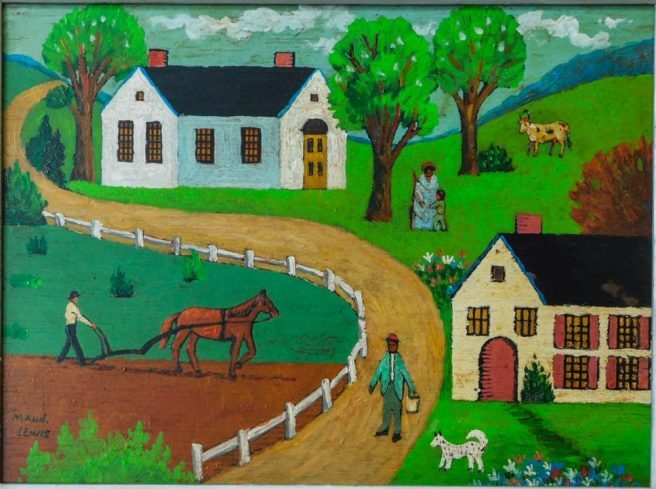
Painting was Maud’s heart and joy, what sustained her through years of hardship and poverty. She loved the process of creating pictures based on happy memories of her childhood back in Yarmouth, or everyday life as viewed through her front window, the only source of light for her work.
She loved seeing the enjoyment her art brought others. Most of her hundreds of paintings were small in scale (about 8” x 10”) because of her limited range of arm motion. She did paint a few larger works and some house shutters, but those were the exception.
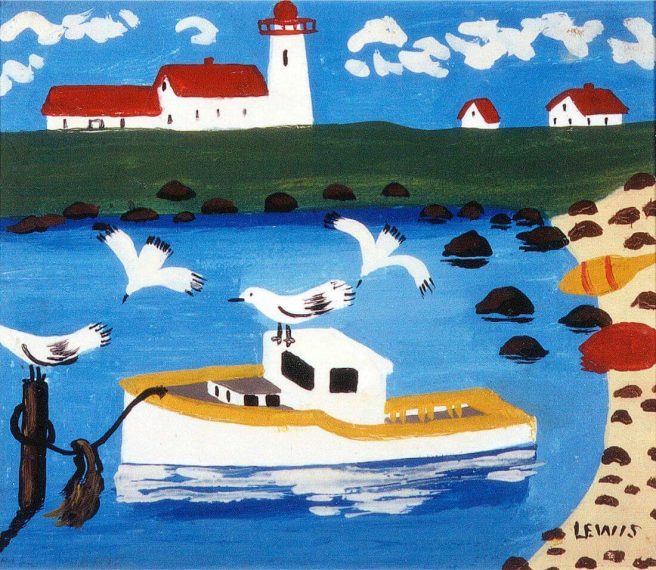

Maud continued to paint prolifically in relative obscurity until gaining national attention in 1964-65 because of several documentaries and newspaper and magazine articles. The Nixon administration even commissioned two paintings from her, and during the last years of her life, she was unable to keep up with the flood of orders.
Maud died in 1970, partially from malnutrition, but also because she contracted pneumonia (she suffered lung damage after years of inhaling paint fumes and wood smoke). She was buried in a child’s coffin and her name was added to a family headstone along with the names of Everett and his parents.
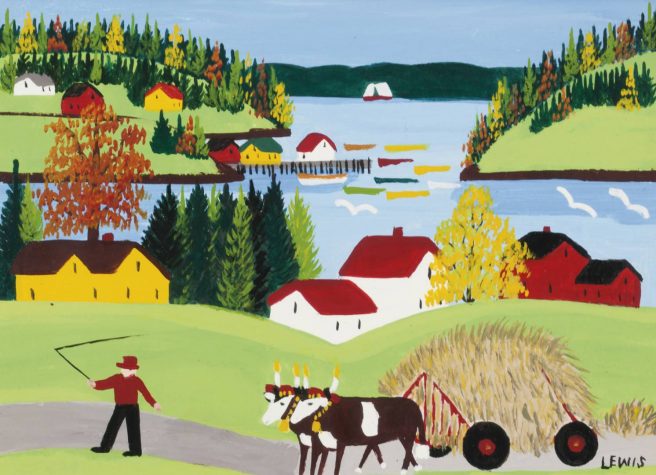
Not surprisingly, after Maud’s death the demand for her art grew exponentially, prompting forgeries even by Everett, who outlived her by 9 years. He also met a tragic end, having been murdered at home during a robbery attempt (some say it was because he had publicly bragged about burying money on his property).
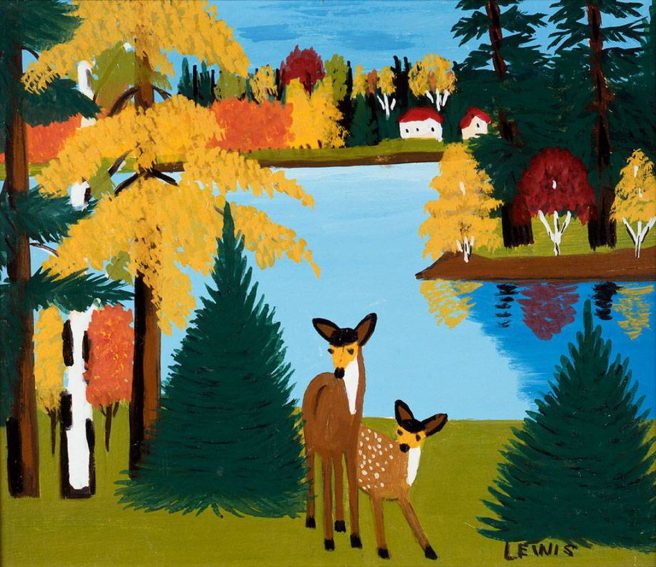


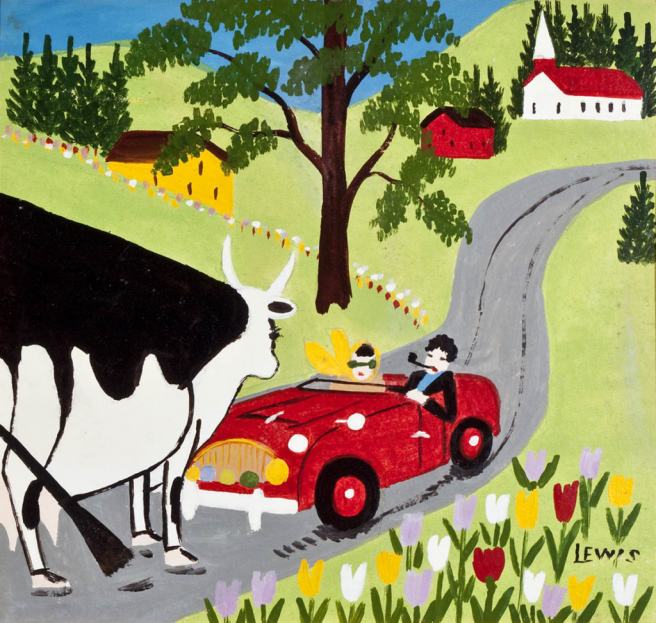
Today, Maud remains one of Canada’s most beloved folk artists. During her lifetime, her paintings never sold for more than $10. In recent years, her work has sold at auction for as much as $45,000. All this, for someone whose experience of the world extended only from the area of her birthplace to her home in Marshalltown.
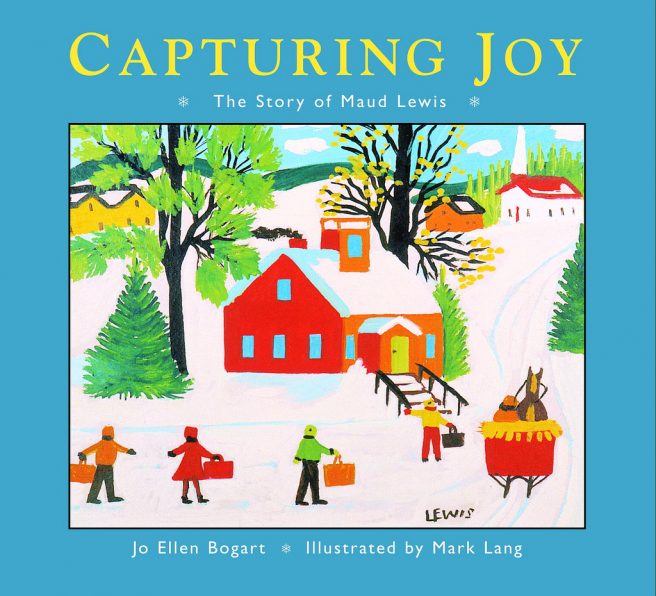
Her work has inspired several books, plays and films, the most notable of which is the 2017 full length movie, “Maudie,” starring Sally Hawkins as Maude and Ethan Hawke as Everett. Its release sparked renewed fervor over her work.



Maud and Everett’s house was lovingly restored and is now part of a permanent exhibit at The Art Gallery of Nova Scotia. There is a steel memorial replica of the house at the original site in Marshalltown.
Art for Maud was comfort, purpose, sanctuary, and satisfaction. She painted, over and over, about a time in her life — childhood — when she was happiest, preserving it in the only way she knew how. She imbued the quiet, rural life she cherished with a timeless quality.
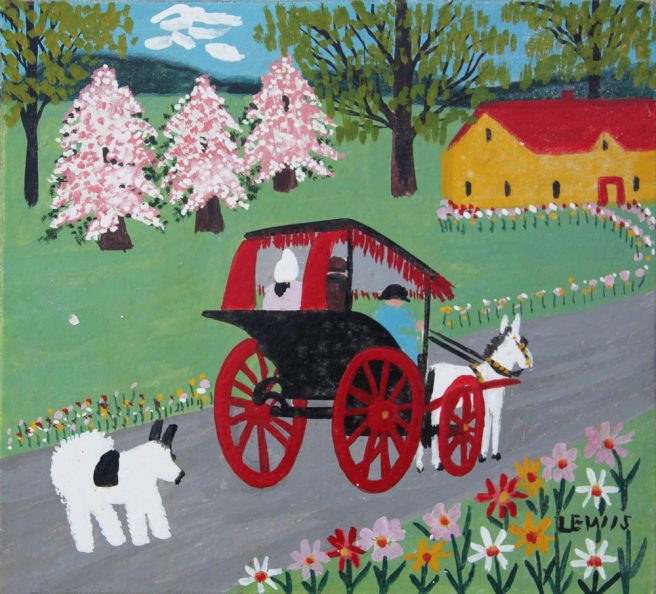


Maud created her own ideal world — full of bright colors, her favorite animals (cats, deer, oxen, cows, horses, seagulls), horse drawn carriages, sleighs, cozy winter landscapes, and those ubiquitous pink and white blossoms.

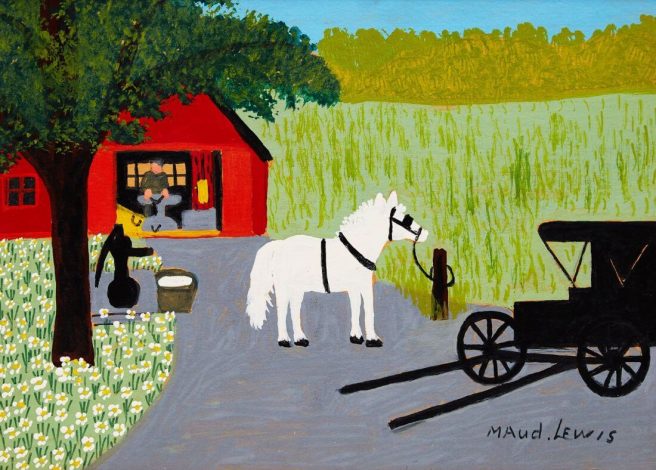
Her story speaks to the triumph of the human spirit and the importance of appreciating the simple things in life. In finding her own joy, she continues to bring joy to millions of others.
Enjoy this clip from the 1965 CBC documentary to hear from Maud herself:
Here’s the official trailer for “Maudie”:
“Maudie” can be rented for a few dollars via Prime Video. So good!
ETA: After completing this post, I read Maud Lewis: The Heart on the Door by Lance Woolaver (2016), the only full length biography written about her. He paints a much darker picture of Everett Lewis, detailing verbal abuse, exploitation, “dirty old man” reputation, and extreme miserly practices.
Even after they could afford it, he refused to update their cottage with basic amenities because he felt that if people pitied Maud, they would continue to receive handouts and charity from their neighbors and even perfect strangers. He even refused to allow a well meaning friend to install a bathroom free of charge (as it was, Maud had to go to the nearby Poor Farm to bathe, etc.).
For 30 years, Maud was not even allowed to cross the street to visit their neighbors. A fascinating and compelling biography at a whopping 500 pages if you can withstand incessant repetition, digressions, and occasional conjecture. A good editor would have made a world of difference in helping to shape the mountains of data Woolaver collected over several decades.
*Copyright © 2021 Jama Rattigan of Jama’s Alphabet Soup. All rights reserved.

Jama, I love this post! I discovered Maud Lewis just this year as I was look around for paintings of ox (my olw for 2021) and oxen. You have several in this post! Thank you for highlighting this very special artist. What a treasure.
LikeLiked by 2 people
Did you notice how she painted eyelashes on her oxen? 🙂 Her father was a harness maker and blacksmith, so she would have seen lots of these animals during her childhood.
LikeLiked by 1 person
What a wonderful post about an amazing woman! She is new to me and I am so glad to meet her. Thank you!
LikeLiked by 2 people
Hers is a fascinating life story — so many tragic elements, yet her art sustained her. So inspiring!
LikeLike
What cheerful images!
LikeLiked by 1 person
Cheery and sunny — the work of an optimist.
LikeLiked by 1 person
Yes!
LikeLike
What a story! It sounds as though her life was so difficult, and yet her art is so bright and happy! Ruth, thereisnosuchthingasagodforsakentown.blogspot.com
LikeLiked by 1 person
Can’t imagine how she managed all those years. Those Canadian winters must have been brutal. Just going to the outhouse must have been something.
LikeLiked by 1 person
Wow–so much heart and joy in her paintings despite her difficult life! It probably kept her going! Will look for that film. Thanks for sharing, Jama 🙂
LikeLiked by 2 people
The film is worth seeing — it’s what made me want to learn more about her life.
LikeLiked by 1 person
Delighted to learn about her! When I was a child, our family traveled to Eastern Canada numerous times and her paintings bring back happy memories. Thanks, Jama!
LikeLiked by 1 person
Hooray for happy memories! If she only knew how much joy her work continues to give so many.
LikeLike
What an endearing person she was, to find the joy she needed despite all the hardship. She is new to me, Jama. Thank you for featuring her & those wonderful paintings. I will look for the movie. I noticed those three black cats were there more than once, wonderful!
LikeLiked by 1 person
Her cat paintings are kind of like her trademark.
LikeLike
Thank you, Jama, for teaching me more about Maude Lewis’ terrible, beautiful life, and her core of joy which shines through all the troubles so brightly.
LikeLiked by 1 person
She deserves a hero’s medal just for putting up with Everett. She was his cash cow, yet he treated her so poorly. In the Woolaver biography, I read that Everett used to pinch female customers who came to the house on their bottoms. His own family didn’t allow young female relatives around Everett because he was a known molester.
LikeLike
I had forgotten about this amazing lady! I’m so sorry that, like Vincent van Gogh, she never made the living she deserved from her charming paintings. And sorry she had to deal with a not-so-savory husband. Her little cottage was so bright and cheery. What a spirit she had! I’m going to check out that movie on Prime! Thanks for the post and all the wonderful photos of her work!
LikeLiked by 1 person
I know you’ll enjoy the movie, Jan. Thanks for stopping by to read about Maud, a constant inspiration.
LikeLike
Oh Maude! I’m going to focus on the joy in her work despite the hardships and cruelty that she endured. I hope they were both an outlet and a channel to happiness and fulfillment.
LikeLiked by 1 person
Physically small and frail, but mentally and emotionally made of steel.
LikeLiked by 1 person
Wonderful to see Maude Lewis on your blog, Jama! I discovered her a few years ago, and I was so moved by her art and her life (though horrified by Everett). She endured so much pain, and yet shared so much beauty.
LikeLiked by 1 person
I became aware of her work a couple of years ago too, but only recently saw the film “Maudie,” which made me want to learn more about her life and struggles. Apparently only Everett called her “Maudie.” Her family called her “Little Maud.”
LikeLike
Thank you for introducing me to this wonderful, unique artist.
Tambra Nicole Kendall
LikeLiked by 1 person
You’re welcome!! Thanks for visiting.
LikeLike
I had not heard of Maude Lewis before – amazing artist. I just watched the movie.
Thank you.
LikeLiked by 1 person
Glad you watched the movie. I liked both of the main actors, and it was interesting seeing the area of Nova Scotia where Maud and Everett lived.
LikeLike